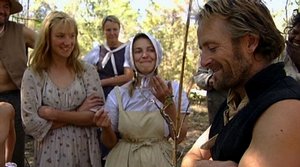
A day of celebration or mourning? A land of plenty or hardship? For Australia Day, we consider national history from different perspectives.
Britain staked its claim to Australia on 26 January 1788, with the arrival in Sydney Cove of Captain Arthur Phillip and the convict First Fleet. But it was only in 1935 that the states and territories all agreed to celebrate a national day on 26 January and to call it 'Australia Day’. A few years later, on the sesquicentenary of 1938, Indigenous Australians labelled it a 'day of mourning’. For more on Aboriginal activism in the 1930s, see Lousy Little Sixpence (1983), clip three.
The makers of a British newsreel in 1947 declared Australia a Land Short of People and urged Europeans to migrate. Among the countries to respond was Germany, whose presence in Australia dates back to the earliest days of white settlement (see Some of Many: Germans in Australia, 1983). Completed the same year as Lousy Little Sixpence and Some of Many, For Love or Money (1983) was an epic feminist undertaking that documented the history of women and work in Australia from 1788.
The first film deemed worthy of a gold medal at the AFI Awards was The Land That Waited (1963), an early ABC documentary that portrayed Australia as the first white arrivals saw it. Forty years later, the SBS reality show The Colony went one better, with participants reliving the early years of the colony by taking on the roles of convicts, free settlers and Indigenous Australians.
Read more about Australia Day here and on the official website.









